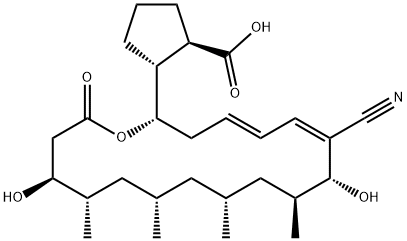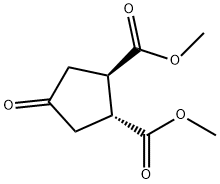Description
Borrelidin (7184-60-3) ia a novel macrolide which inhibits bacterial and eukaryotic threonyl-tRNA synthetase.1 Displays potent anti-angiogenic activity (IC50=0.8 nM) and induces the collapse of newly formed capillary tubules.2 Modulates alternative splicing of VEGF in favor of anti-angiogenic isoforms.3 Induces apoptosis in ALL cell lines.4 Induces unfolded protein response in oral cancer cells.5 Cell permeable.
Uses
Borrelidin is a secondary metabolite produced by Streptomyces and other bacteria. It displays potent antiangiogenic activity, preventing tube formation in rat aorta explants (IC50 = 0.8 nM) and inducing apoptosis in endothelial cells. Borrelidin also alters the splicing of VEGF mRNA, producing an antiangiogenic isoform of the growth factor. It has long been known as a powerful inhibitor of both eukaryotic and bacterial threonyl tRNA synthetase. Borrelidin is also an effective anti-malarial drug, as it kills P. falciparum with an IC50 value of 1.8 nM. At higher doses, it inhibits cyclin-dependent kinase in yeast (IC50 = 24 μM), resulting in growth arrest in the G1 phase.
Uses
Borrelidin is an unusual nitrile-containing metabolite isolated from Streptomyces. Originally discovered as active against Borrelia species, borrelidin has since found a role as a selective inhibitor of bacterial and eukaryal threonyl-tRNA synthetase. More recent research has found that borrelidin is a very potent angiogenesis inhibitor and induces apoptosis of the capillary tube-forming cells. Borrelidin is an important lead for antimalarial discovery, displaying activity against drug-resistant Plasmodia.
Definition
ChEBI: A macrolide that is isolated from several Streptomyces species and displays antibiotic, antineoplastic and antimalarial properties.
General Description
Chemical structure: macrolide
Biochem/physiol Actions
Borrelidin is a potent angiogenesis inhibitor that induces apoptosis in capillary tube-forming cells. Also displays antimalarial activity against drug-resistant Plasmodia. Antimicrobial and selective threonyl t-RNA synthetase inhibitor.
References
References/Citations
1) Ruan et al. (2005), A unique hydrophobic cluster near the active site contributes to differences in borrelidin inhibition among threonyl-tRNA synthetases; J. Biol. Chem., 280 571
2) Kawamura et al. (2003), Anti-angiogenesis effects of borrelidin are mediated through distinct pathways: threonyl-tRNA synthase and caspases are independently involved in suppression of proliferation and induction of apoptosis in endothelial cells; J. Antibiot., 56 709
3) Woolard et al. (2011) Borrelidin modulates the alternative splicing of VEGF in favour of anti-angiogenic isoforms; Chem. Soc. 2011 273
4) Habibi et al. (2012), Borrelidin, a small molecule nitrile-containing macrolide inhibitor of threonyl-tRNA synthase, is a potent inducer of apoptosis in acute lymphoblastic leukemia; Invest. New Drugs, 30 1361
5) Sidhu et al. (2015), Borrelidin Induces the Unfolded Protein Response in Oral Cancer Cells and Chop-Dependent Apoptosis; ACS Med. Chem. Lett., 6 1122




